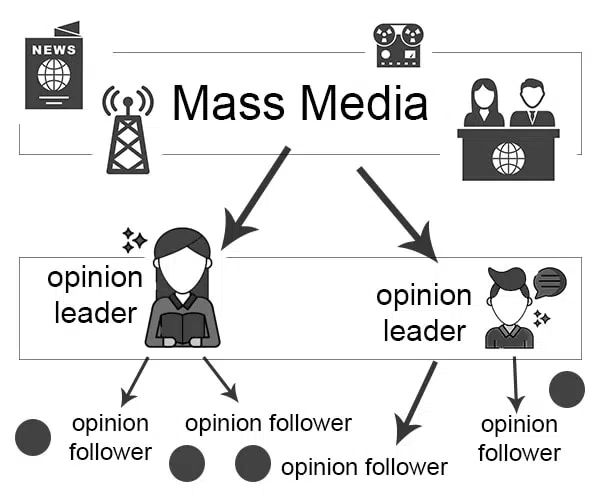
What is the Two-Step Flow Theory?
Paul Lazarsfeld and his team founded the two-step flow theory in the 1940s. It looks at how mass media affects what people think. This idea came about when the media, like newspapers and radio, were really starting to shape public opinion. Lazarsfeld and his group did a study called “The People’s Choice” (1944) during the 1940 presidential election to find out how voters made their choices. The theory suggests that rather than the media directly informing the masses, it first reaches opinion leaders who then pass their opinions onto followers or other people. This filters the information being broadcast to the public.
According to the Two-Step flow theory, media messages first reach opinion leaders—individuals who are more exposed to media and have specific expertise in certain areas. Opinion leaders will gather information about a specific thing in the media and then interpret and filter it before passing it on to their followers. The theory focuses on interpersonal communication. It highlights the crucial role of networks of communication when it comes to media being shared. Over time, people have become more reliant on opinion leaders, especially with the rise of social media influencers. Therefore, the theory is still highly relevant today, with social media platforms such as X and Instagram being filled with social media influencers of all types, such as activists or just content creators who have built up a reputable reputation online. For example, Joe Rogan, who has the world’s most popular podcast, has 16 to 24 million monthly downloads on his podcast, where he features a plethora of guests, all with influential power.
A clear example of the Two-Step flow theory can be seen in the impact of social media influencers on consumer behaviour. When Apple released the first iPhone in 2007, it ran a big marketing campaign to promote the new device. However, many potential buyers looked to influencers and YouTube reviewers for opinions about the iPhone. This helped them decide if buying it was worth it. While the initial communication came from Apple’s advertising (the media), it was the opinion leaders (the reviewers) who ultimately influenced public perception of the iPhone.
Digital platforms are not the only platforms where opinion leaders hold power over their audience. It can be seen across a wide spectrum of contexts, such as political campaigns. People will have established trust with their chosen party or politician and, therefore, are more likely to let their opinion be influenced by these people.
However, the two step flow studies were conducted in the 1940’s-1950’s and therefore could raise doubts on how the theory can be generalised over time with the media being a fast paced environment. It may not fully capture 21st-century communication.
Therefore, the two-step flow theory has significantly contributed to our understanding of influence and communication in the media and the importance of interpersonal relationships.
References:
Two-Step Flow Theory Of Media Communication
https://lowerstreet.co/statistics/joe-rogan
Vorobyev, Alexey N. “The rise of American electoral research: Paul F. Lazarsfeld and ‘The People’s Choice.’” Sot͡s︡iologicheskiĭ Zhurnal, vol. 24, no. 3, 2018, pp. 163–179, https://doi.org/10.19181/socjour.2018.24.3.5998.


Hi! This post was an effective look into how the two-step flow theory works. Explaining the theory and how it played out in 1940 versus how it is being applied to today was really helpful in getting the full idea of the theory. You make a good point about how there are similarities but how it shouldn’t be generalized to fit 21st century communication.